BAN NAM KHEM, Thailand (AP) — The 20-year-old freshman student was still asleep that Sunday morning at the family's house on the Andaman Sea coast of southern Thailand when her mom, sensing something wasn't right, woke her up saying they needed to leave right away.
The day is forever seared in Neungduangjai Sritrakarn's memory: Dec. 26, 2004, the day the deadly Indian Ocean tsunami struck across South and Southeast Asia, after a 9.1 magnitude earthquake off the west coast of Indonesia’s Sumatra island.
Click to Gallery
A visitor looks at coastal reconnaissance boat T215 at Tsunami memorial in Phang Nga Naval Base province, southern Thailand, Tuesday, Dec. 10, 2024. (AP Photo/Sakchai Lalit)
A motorcycle rides past a tsunami evacuation route sign Ban Nam khem, Takuapa district of Phang Nga province, southern Thailand, Monday, Dec. 9, 2024. (AP Photo/Sakchai Lalit)
People fish at Ban Nam Khem Beach, where tsunami hit 2004, Takuapa district of Phang Nga province, southern Thailand, Monday, Dec. 9, 2024. (AP Photo/Sakchai Lalit)
Fisherman collect fish at Ban Nam Khem, where tsunami hit 2004, Takuapa district of Phang Nga province, southern Thailand, Monday, Dec. 9, 2024. (AP Photo/Sakchai Lalit)
A fishing boat is back on shore at Ban Nam Khem, where tsunami hit 2004, Takuapa district of Phang Nga province, southern Thailand, Monday, Dec. 9, 2024. (AP Photo/Sakchai Lalit)
Flowers hang on tiled memorial wall displaying names of victims from the tsunami 2004 in Tsunami memorial park, at Ban Nam Khem, Takuapa district of Phang Nga province, southern Thailand, Monday, Dec. 9, 2024. (AP Photo/Sakchai Lalit)
Tourist walk in from Tsunami Memorial poster at Khao Lak, Takuapa district of Phang Nga province, southern Thailand, Sunday, Dec. 8, 2024. (AP Photo/Sakchai Lalit)
Boats float on Bang Niang Beach, where tsunami hit 2004, Takuapa district of Phang Nga province, southern Thailand, Sunday, Dec. 8, 2024. (AP Photo/Sakchai Lalit)
A survivor from tsunami Somnuek Chuaykerd talks to the Associated Press reporters during an interview show emergency bag with important document at Ban Nam Khem, Takuapa district of Phang Nga province, southern Thailand, Monday, Dec. 9, 2024. (AP Photo/Sakchai Lalit)
A woman walks on Bang Niang Beach, where tsunami hit 2004, Takuapa district of Phang Nga province, southern Thailand, Sunday, Dec. 8, 2024. (AP Photo/Sakchai Lalit)
Tourist take pictures beside photo of who dead by Tsunami memorial tree Nang Thong Beach, Takuapa district of Phang Nga province, southern Thailand, Tuesday, Dec. 10, 2024. (AP Photo/Sakchai Lalit)
A survivor from tsunami Assistant of village chief Sanya Kongma, talks to the Associated Press reporters during an interview tsunami hit to Ban Nam khem, Takuapa district of Phang Nga province, southern Thailand, Monday, Dec. 9, 2024. (AP Photo/Sakchai Lalit)
Tourists play on Bang Niang Beach, where tsunami hit 2004, Takuapa district of Phang Nga province, southern Thailand, Sunday, Dec. 8, 2024. (AP Photo/Sakchai Lalit)
An area view Khao Lak beach, where tsunami hit 2004, Takuapa district of Phang Nga province, southern Thailand, Tuesday, Dec. 10, 2024. (AP Photo/Sakchai Lalit)
Tourists look at Police Boat T813 that was swept inland at Tsunami Memorial Khao Lak, Takuapa district of Phang Nga province, southern Thailand, Sunday, Dec. 8, 2024. (AP Photo/Sakchai Lalit)
A survivor from tsunami Nuengduangjai Sritrakarn talks to the Associated Press reporters during an interview explain tsunami hit to Ban Nam khem, Takuapa district of Phang Nga province, southern Thailand, Monday, Dec. 9, 2024. (AP Photo/Sakchai Lalit)
Visitors looks at a tiled memorial wall displaying names of victims from the tsunami 2004 in Tsunami memorial park, at Ban Nam Khem, Takuapa district of Phang Nga province, southern Thailand, Monday, Dec. 9, 2024. (AP Photo/Sakchai Lalit)
It was one of modern history’s worst natural disasters.
Neungduangjai's mom had noticed a strange pattern of whitecaps on the sea, just as a relative who returned from a fishing trip came by to warn them. They grabbed all the family members' essential documents and hopped on motorbikes.
Within minutes, Neungduangjai, her mother, father, brother and sister were speeding away, trying to get as far as they could from their village of Ban Nam Khem. Looking back, Neungduangjai saw a surging wall of water, taller than her home, moving toward shore from far away.
She had never seen anything like it.
They got about 3 kilometers (1.8 miles) away when the wall of water crashed into the shore of Phang Nga province and caught up with them, knocking them off their bikes. The water was dark, sweeping all kinds of objects, man-made and natural.
Nuengduangjai pulled herself to her feet but could barely stand in the moving mass — the water was almost up to her knees.
She didn't know at the time that the tsunami had hit a dozen countries, leaving about 230,000 dead, around a third of them in Indonesia. Some 1.7 million people were displaced, mostly in the four worst-affected countries: Indonesia, Sri Lanka, India and Thailand.
Along Thailand’s Andaman coast, at least 5,400 people were killed and some 3,000 remain missing to this day, according to the Thai government.
The shrimp farm where Neungduangjai’s family worked and lived was wiped out.
In its place today is a thriving bar and restaurant — the fruits of Neungduangjai’s rebuilding efforts — with a porch looking out to a beautiful sea view. A view she said wouldn’t be there if not for the tsunami that destroyed parts of the coast.
In Phang Nga, life has been rebuilt and the tourists are back — on the surface, all is fine.
Neungduangjai, who was home from her studies in Bangkok for the New Year break when the tsunami hit, said her immediate family survived but they lost five relatives, including her grandparents. One of her uncles was never found.
After a week of staying with relatives in nearby Ranong province, she went back. She remembers the stench of death and how she thought everything had been moved from its original place.
“There were bodies everywhere,” she said. “When I returned to the village, I couldn’t recognize a single thing. ... Everything was different.”
Though tourists have little reason to notice them, reminders of the tragedy abound today in Phang Nga — signs showing an evacuation route, tsunami shelters near beach areas, several memorials and museums displaying wreckage and photos that tell the story of that day.
Sanya Kongma, the assistant to Ban Nam Khem's village chief, said development has come a long way, and that the quality of life in the village is good compared to 20 years ago.
But the haunting memories and the trauma of what they lived through are very much present and fear is never far away, he said.
"Even now ... if there’s an announcement from the government on TV, or whatever, that there’s an earthquake in Sumatra, everyone will be spooked,” he said.
About once a year, a siren blares off in a tsunami evacuation drill. But what is meant to reassure residents of their safety can cause some survivors to relive their pain.
Somneuk Chuaykerd lost one of her young sons to the tsunami while she was out at sea, fishing with her husband.
The 50-year-old still lives in the same spot, the sea right at her backyard. In evacuation drills, she has learned to keep an emergency tote bag with all important documents. The bag is in her bedroom, along with a photo of the little boy she lost.
But the siren freezes her up every time and sends her heartbeat racing. “I don’t know what to do. I don’t know what to grab,” she says. “It's so scary.”
But she has made peace with the tragedy and has no plans to move away.
"I live by the sea. This is my living. I don’t have anywhere else to go,” she said.
As for Nuengduangjai, for years after the tsunami, every time she looked at the sea she would get a panic attack. A roaring sound of waves haunted her in her sleep.
She chose to move back home after college and make a living right next to the sea. She is proud of her bar and restaurant.
“I’m still scared, but I have to live with it, because it’s my home," she said. "Some people moved away, but I did not. I’m still here.”

A visitor looks at coastal reconnaissance boat T215 at Tsunami memorial in Phang Nga Naval Base province, southern Thailand, Tuesday, Dec. 10, 2024. (AP Photo/Sakchai Lalit)
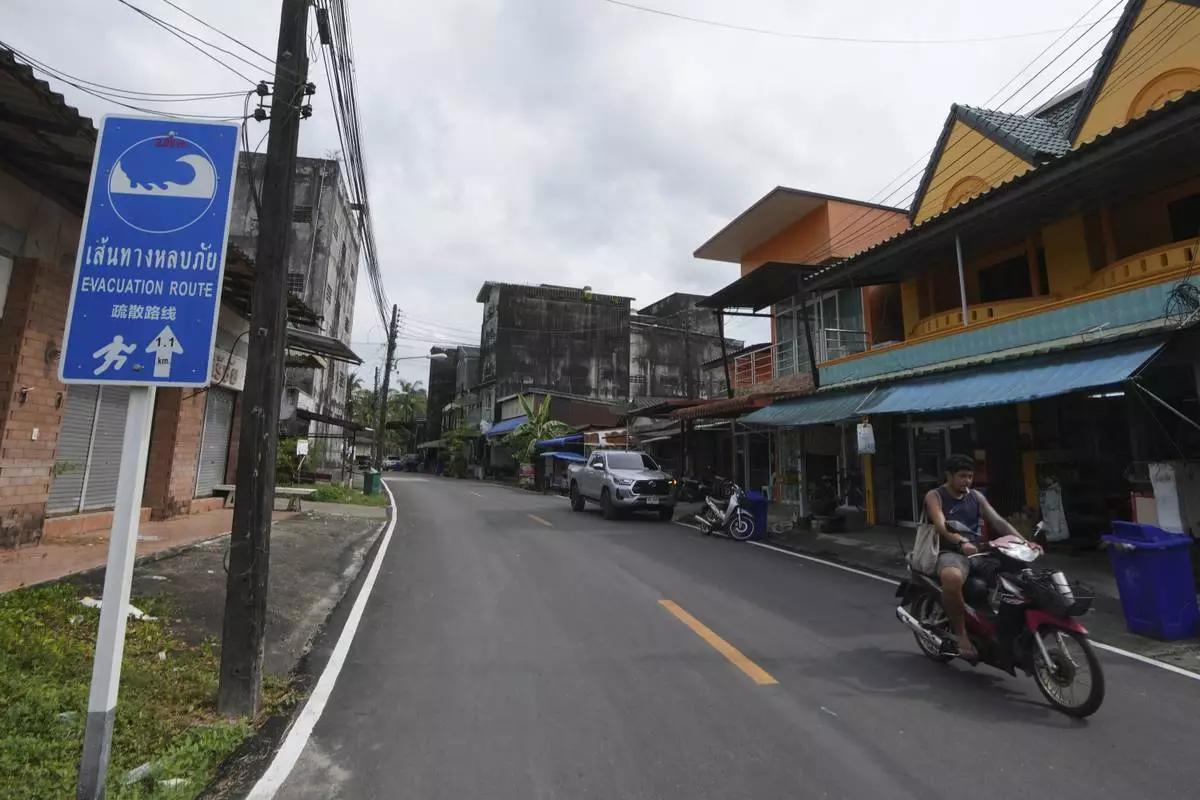
A motorcycle rides past a tsunami evacuation route sign Ban Nam khem, Takuapa district of Phang Nga province, southern Thailand, Monday, Dec. 9, 2024. (AP Photo/Sakchai Lalit)
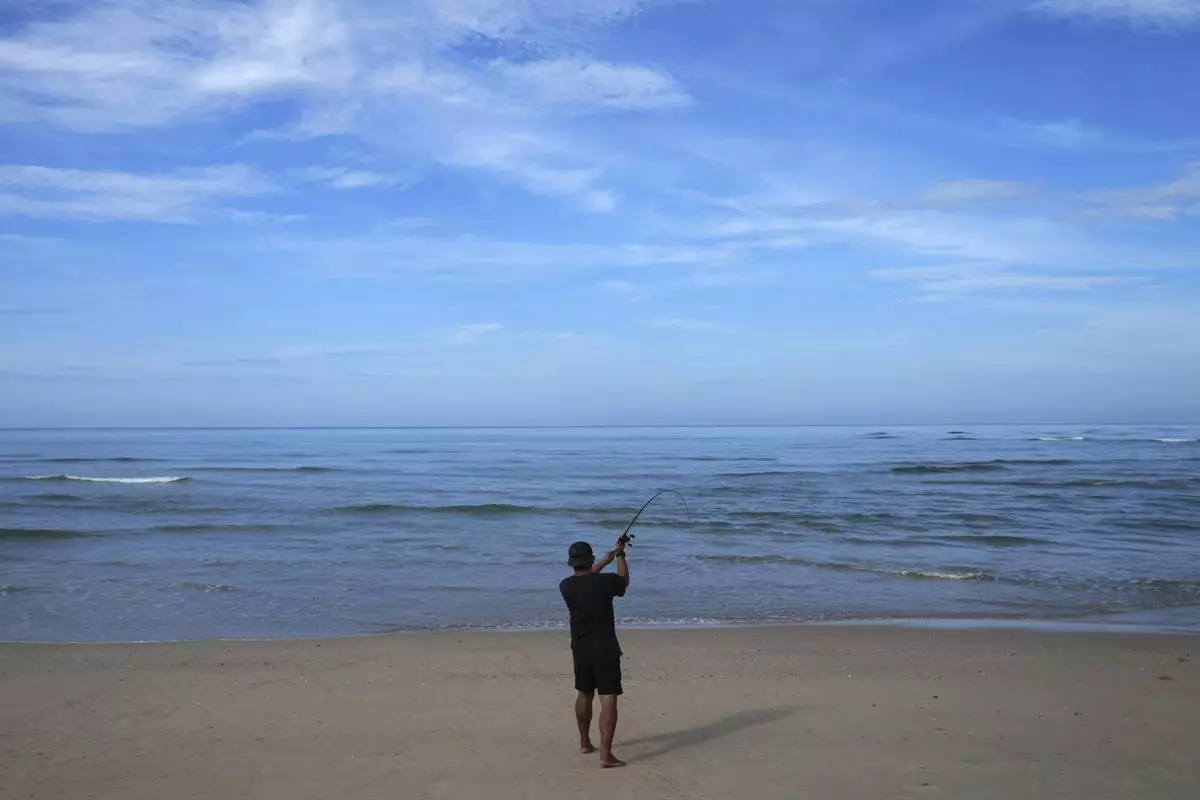
People fish at Ban Nam Khem Beach, where tsunami hit 2004, Takuapa district of Phang Nga province, southern Thailand, Monday, Dec. 9, 2024. (AP Photo/Sakchai Lalit)

Fisherman collect fish at Ban Nam Khem, where tsunami hit 2004, Takuapa district of Phang Nga province, southern Thailand, Monday, Dec. 9, 2024. (AP Photo/Sakchai Lalit)

A fishing boat is back on shore at Ban Nam Khem, where tsunami hit 2004, Takuapa district of Phang Nga province, southern Thailand, Monday, Dec. 9, 2024. (AP Photo/Sakchai Lalit)
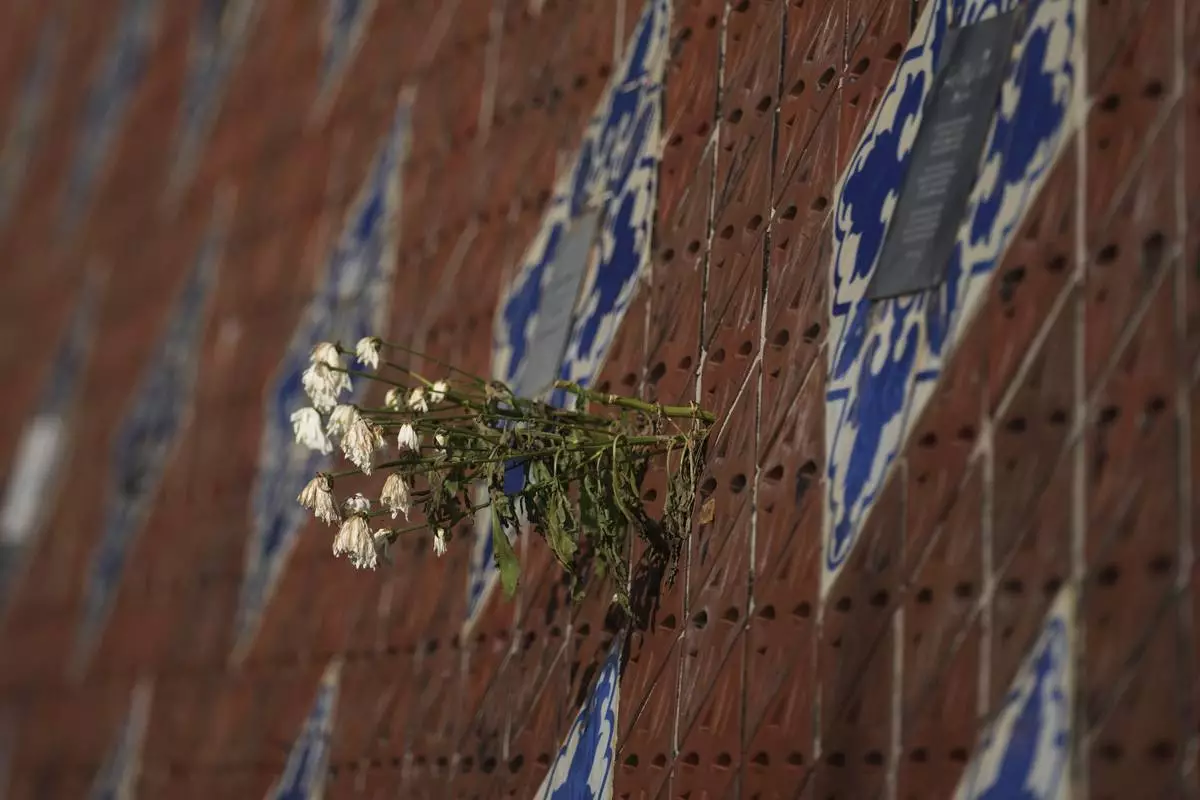
Flowers hang on tiled memorial wall displaying names of victims from the tsunami 2004 in Tsunami memorial park, at Ban Nam Khem, Takuapa district of Phang Nga province, southern Thailand, Monday, Dec. 9, 2024. (AP Photo/Sakchai Lalit)

Tourist walk in from Tsunami Memorial poster at Khao Lak, Takuapa district of Phang Nga province, southern Thailand, Sunday, Dec. 8, 2024. (AP Photo/Sakchai Lalit)

Boats float on Bang Niang Beach, where tsunami hit 2004, Takuapa district of Phang Nga province, southern Thailand, Sunday, Dec. 8, 2024. (AP Photo/Sakchai Lalit)

A survivor from tsunami Somnuek Chuaykerd talks to the Associated Press reporters during an interview show emergency bag with important document at Ban Nam Khem, Takuapa district of Phang Nga province, southern Thailand, Monday, Dec. 9, 2024. (AP Photo/Sakchai Lalit)

A woman walks on Bang Niang Beach, where tsunami hit 2004, Takuapa district of Phang Nga province, southern Thailand, Sunday, Dec. 8, 2024. (AP Photo/Sakchai Lalit)

Tourist take pictures beside photo of who dead by Tsunami memorial tree Nang Thong Beach, Takuapa district of Phang Nga province, southern Thailand, Tuesday, Dec. 10, 2024. (AP Photo/Sakchai Lalit)

A survivor from tsunami Assistant of village chief Sanya Kongma, talks to the Associated Press reporters during an interview tsunami hit to Ban Nam khem, Takuapa district of Phang Nga province, southern Thailand, Monday, Dec. 9, 2024. (AP Photo/Sakchai Lalit)

Tourists play on Bang Niang Beach, where tsunami hit 2004, Takuapa district of Phang Nga province, southern Thailand, Sunday, Dec. 8, 2024. (AP Photo/Sakchai Lalit)

An area view Khao Lak beach, where tsunami hit 2004, Takuapa district of Phang Nga province, southern Thailand, Tuesday, Dec. 10, 2024. (AP Photo/Sakchai Lalit)
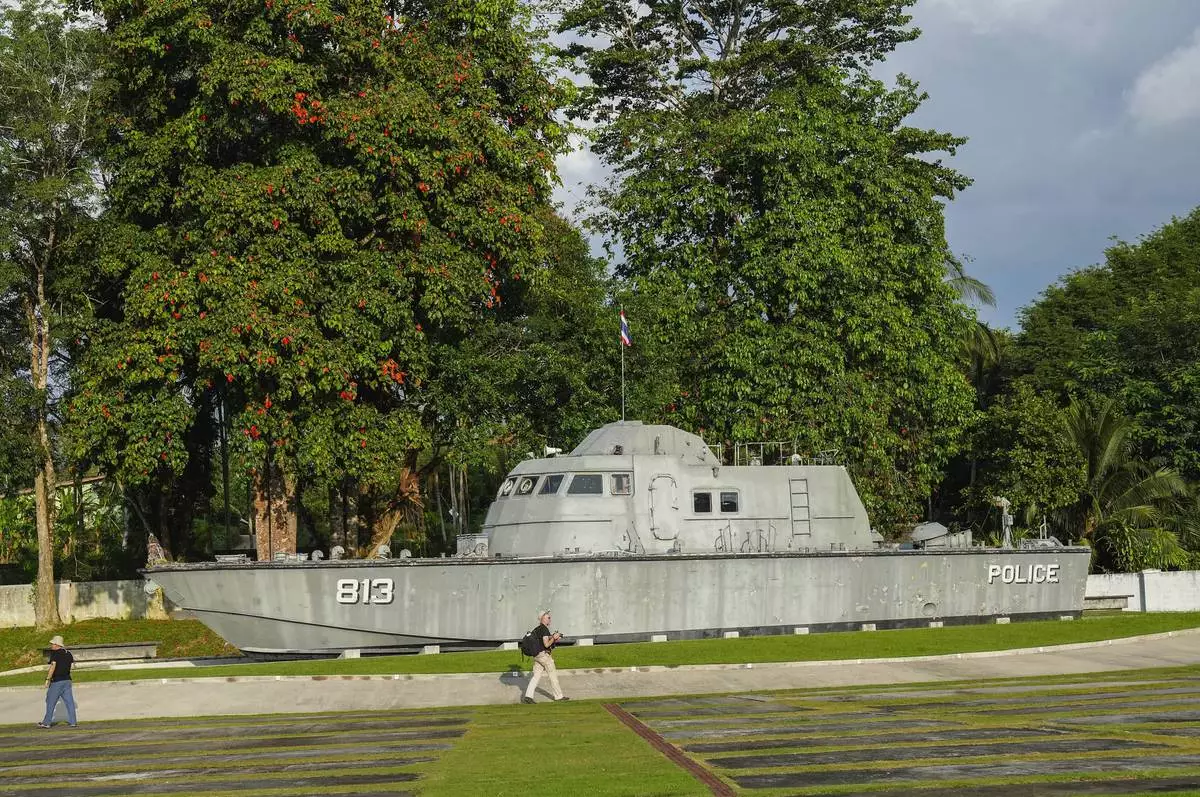
Tourists look at Police Boat T813 that was swept inland at Tsunami Memorial Khao Lak, Takuapa district of Phang Nga province, southern Thailand, Sunday, Dec. 8, 2024. (AP Photo/Sakchai Lalit)

A survivor from tsunami Nuengduangjai Sritrakarn talks to the Associated Press reporters during an interview explain tsunami hit to Ban Nam khem, Takuapa district of Phang Nga province, southern Thailand, Monday, Dec. 9, 2024. (AP Photo/Sakchai Lalit)

Visitors looks at a tiled memorial wall displaying names of victims from the tsunami 2004 in Tsunami memorial park, at Ban Nam Khem, Takuapa district of Phang Nga province, southern Thailand, Monday, Dec. 9, 2024. (AP Photo/Sakchai Lalit)
DUBAI, United Arab Emirates (AP) — Two U.S. Navy pilots were shot down Sunday over the Red Sea in an apparent “friendly fire” incident, the U.S military said, marking the most serious incident to threaten troops in over a year of America targeting Yemen's Houthi rebels.
Both aviators were recovered alive after ejecting from their stricken two-seat F/A-18 aircraft, with one suffering minor injuries. But the shootdown underlines just how dangerous the Red Sea corridor has become, with ongoing attacks on shipping by the Iranian-backed Houthis despite U.S. and European military coalitions patrolling the area.
The U.S. military had conducted airstrikes targeting Yemen’s Houthi rebels at the time of the friendly fire incident, though the U.S. military’s Central Command did not elaborate on what the pilots' mission was and did not respond to questions from The Associated Press.
The F/A-18 shot down had just flown off the deck of the USS Harry S. Truman aircraft carrier, Central Command said. On Dec. 15, Central Command acknowledged the Truman had entered the Mideast, but hadn't specified that the carrier and its battle group was in the Red Sea.
“The guided-missile cruiser USS Gettysburg, which is part of the USS Harry S. Truman Carrier Strike Group, mistakenly fired on and hit the F/A-18,” Central Command said in a statement. “This incident was not the result of hostile fire, and a full investigation is underway.”
From the military's description, the aircraft shot down was a two-seat F/A-18 Super Hornet fighter jet assigned to the “Red Rippers” of Strike Fighter Squadron 11 out of Naval Air Station Oceana, Virginia. While Central Command referred to both as pilots, typically a two-seat F/A-18 has a pilot and a weapons officer on board.
It wasn't immediately clear how the Gettysburg could mistake an F/A-18 for an enemy aircraft or missile, particularly as ships in a battle group remain linked by both radar and radio communication.
However, Central Command said that warships and aircraft earlier shot down multiple Houthi drones and an anti-ship cruise missile launched by the rebels. Incoming hostile fire from the Houthis has given sailors just seconds to make decisions in the past.
Since the Truman's arrival, the U.S. has stepped up its airstrikes targeting the Houthis and their missile fire into the Red Sea and the surrounding area. However, the presence of an American warship group may spark renewed attacks from the rebels, like what the USS Dwight D. Eisenhower saw earlier this year. That deployment marked what the Navy described as its most intense combat since World War II.
On Saturday night and early Sunday, U.S. warplanes conducted airstrikes that shook Sanaa, the capital of Yemen which the Houthis have held since 2014. Central Command described the strikes as targeting a “missile storage facility” and a “command-and-control facility,” without elaborating.
Houthi-controlled media reported strikes in both Sanaa and around the port city of Hodeida, without offering any casualty or damage information. In Sanaa, strikes appeared particularly targeted at a mountainside known to be home to military installations. However, there were no images or information released regarding the strikes — which has happened previously when airstrikes hit vital facilities for the rebels.
Brig. Gen. Yahya Saree, a Houthi military spokesman, released a prerecorded statement hours later in which he claimed the rebels launched eight drones and 17 cruise missiles in their attack. He also claimed without offering any evidence that the Houthis shot down the F/A-18, likely following a pattern of him making exaggerated claims. During the Eisenhower's deployment, he repeatedly falsely claimed the carrier had been struck by Houthi fire.
The Houthis have targeted about 100 merchant vessels with missiles and drones since the Israel-Hamas war in the Gaza Strip started in October 2023 after Hamas’ surprise attack on Israel that killed 1,200 people and saw 250 others taken hostage.
Israel’s grinding offensive in Gaza has killed more than 45,000 Palestinians, local health officials say. The tally doesn’t distinguish between combatants and civilians.
The Houthis have seized one vessel and sunk two in a campaign that has also killed four sailors. Other missiles and drones have either been intercepted by separate U.S.- and European-led coalitions in the Red Sea or failed to reach their targets, which have also included Western military vessels.
The rebels maintain that they target ships linked to Israel, the U.S. or the United Kingdom to force an end to Israel’s campaign against Hamas in Gaza. However, many of the ships attacked have little or no connection to the conflict, including some bound for Iran.
The Houthis also have increasingly targeted Israel itself with drones and missiles, resulting in retaliatory Israeli airstrikes.
On Sunday, Israeli Prime Minister Benjamin Netanyahu said his country would act “forcefully” against the Houthis, as it has against other allies of Iran, “only in this case, we are not acting alone.” Israeli media reports late Sunday, relying on anonymous sources, suggested senior security officials believe that Israel should directly strike Iran over the Houthi attacks, rather than hit targets in Yemen again.

CORRECTS YEAR TO 2024 - The Ticonderoga-class guided-missile cruiser USS Gettysburg (CG 64) steams in the Mediterranean Sea, Dec. 15, 2024. (Kaitlin Young/U.S. Navy via AP)
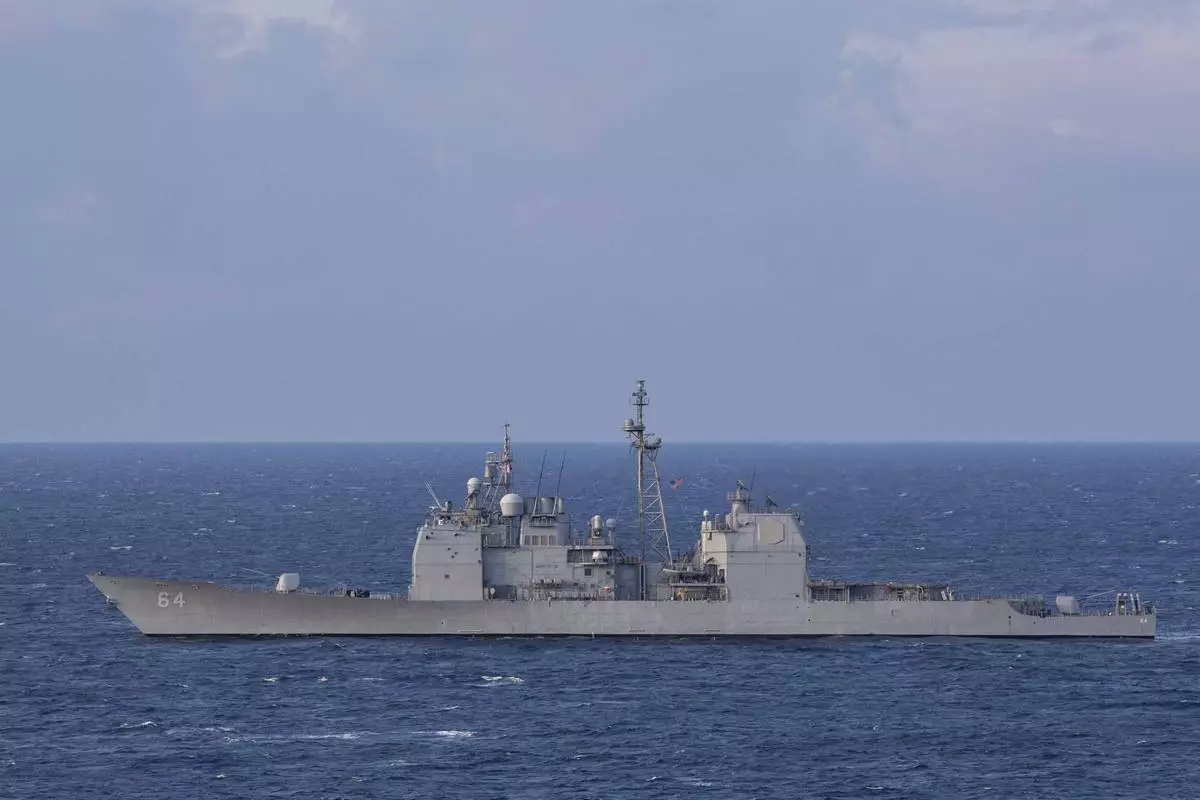
The Ticonderoga-class guided-missile cruiser USS Gettysburg (CG 64) steams in the Mediterranean Sea, Dec. 15, 2025. (Kaitlin Young/U.S. Navy via AP)
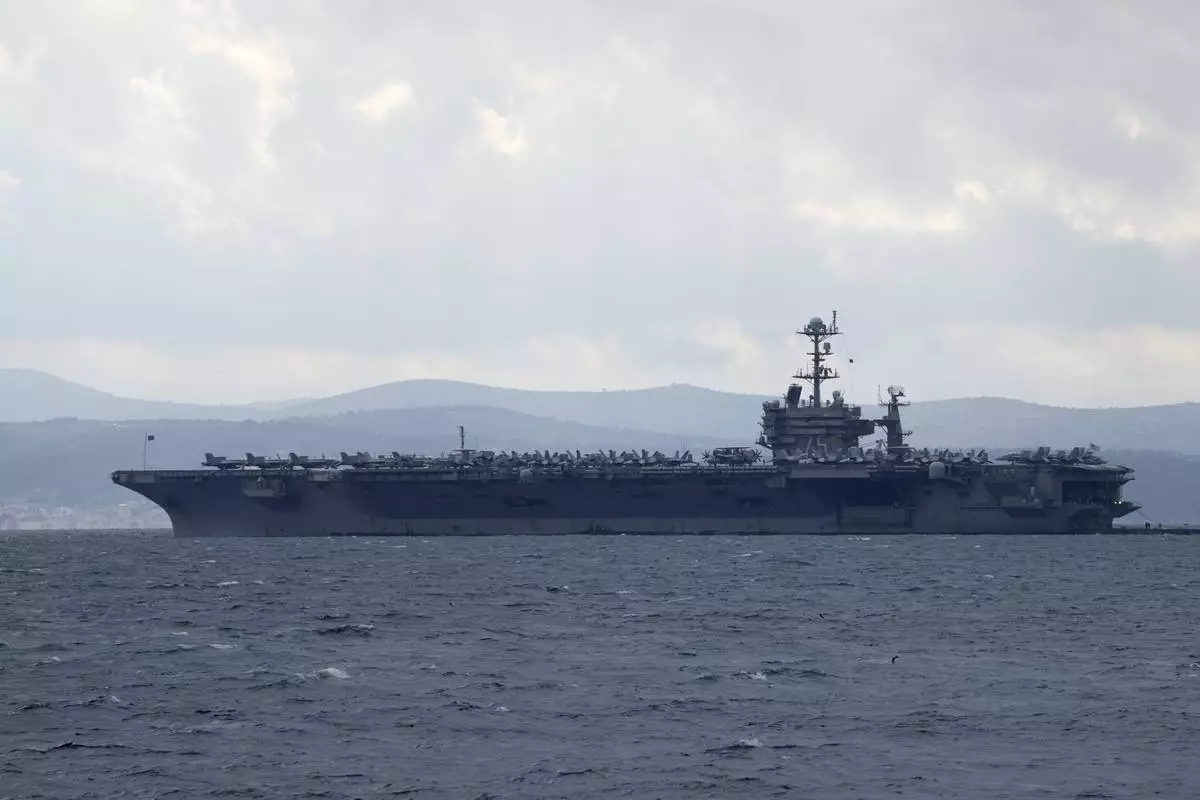
FILE - Aircraft carrier USS Harry S. Truman is moored near Split, Croatia, Feb. 14, 2022. (AP Photo/Darko Bandic, File)

FILE - A fighter jet maneuvers on the deck of the USS Dwight D. Eisenhower in the Red Sea, June 11, 2024. (AP Photo/Bernat Armangue, File)















































